Linyang Li
InternBootcamp Technical Report: Boosting LLM Reasoning with Verifiable Task Scaling
Aug 12, 2025



Abstract:Large language models (LLMs) have revolutionized artificial intelligence by enabling complex reasoning capabilities. While recent advancements in reinforcement learning (RL) have primarily focused on domain-specific reasoning tasks (e.g., mathematics or code generation), real-world reasoning scenarios often require models to handle diverse and complex environments that narrow-domain benchmarks cannot fully capture. To address this gap, we present InternBootcamp, an open-source framework comprising 1000+ domain-diverse task environments specifically designed for LLM reasoning research. Our codebase offers two key functionalities: (1) automated generation of unlimited training/testing cases with configurable difficulty levels, and (2) integrated verification modules for objective response evaluation. These features make InternBootcamp fundamental infrastructure for RL-based model optimization, synthetic data generation, and model evaluation. Although manually developing such a framework with enormous task coverage is extremely cumbersome, we accelerate the development procedure through an automated agent workflow supplemented by manual validation protocols, which enables the task scope to expand rapidly. % With these bootcamps, we further establish Bootcamp-EVAL, an automatically generated benchmark for comprehensive performance assessment. Evaluation reveals that frontier models still underperform in many reasoning tasks, while training with InternBootcamp provides an effective way to significantly improve performance, leading to our 32B model that achieves state-of-the-art results on Bootcamp-EVAL and excels on other established benchmarks. In particular, we validate that consistent performance gains come from including more training tasks, namely \textbf{task scaling}, over two orders of magnitude, offering a promising route towards capable reasoning generalist.
UnitCoder: Scalable Iterative Code Synthesis with Unit Test Guidance
Feb 17, 2025Abstract:Large Language Models (LLMs) have demonstrated remarkable capabilities in various tasks, yet code generation remains a major challenge. Current approaches for obtaining high-quality code data primarily focus on (i) collecting large-scale pre-training data and (ii) synthesizing instruction data through prompt engineering with powerful models. While pre-training data faces quality consistency issues, instruction-based synthesis suffers from limited instruction diversity and inherent biases of LLMs. To address this gap, we introduce UnitCoder, a systematic pipeline leveraging model-generated unit tests to both guide and validate the code generation process. Combined with large-scale package-based retrieval from pre-training corpus, we generate a dataset of 500K+ verifiable programs containing diverse API calls. Evaluations on multiple Python benchmarks (BigCodeBench, HumanEval, MBPP) demonstrate that models fine-tuned on our synthetic data exhibit consistent performance improvements. Notably, Llama3.1-8B and InternLM2.5-7B improve from 31\% and 28\% to 40\% and 39\% success rates on BigCodeBench, respectively. Our work presents a scalable approach that leverages model-generated unit tests to guide the synthesis of high-quality code data from pre-training corpora, demonstrating the potential for producing diverse and high-quality post-training data at scale. All code and data will be released (https://github.com).
FastMCTS: A Simple Sampling Strategy for Data Synthesis
Feb 17, 2025



Abstract:Synthetic high-quality multi-step reasoning data can significantly enhance the performance of large language models on various tasks. However, most existing methods rely on rejection sampling, which generates trajectories independently and suffers from inefficiency and imbalanced sampling across problems of varying difficulty. In this work, we introduce FastMCTS, an innovative data synthesis strategy inspired by Monte Carlo Tree Search. FastMCTS provides a more efficient sampling method for multi-step reasoning data, offering step-level evaluation signals and promoting balanced sampling across problems of different difficulty levels. Experiments on both English and Chinese reasoning datasets demonstrate that FastMCTS generates over 30\% more correct reasoning paths compared to rejection sampling as the number of generated tokens scales up. Furthermore, under comparable synthetic data budgets, models trained on FastMCTS-generated data outperform those trained on rejection sampling data by 3.9\% across multiple benchmarks. As a lightweight sampling strategy, FastMCTS offers a practical and efficient alternative for synthesizing high-quality reasoning data. Our code will be released soon.
GAOKAO-Eval: Does high scores truly reflect strong capabilities in LLMs?
Dec 13, 2024Abstract:Large Language Models (LLMs) are commonly evaluated using human-crafted benchmarks, under the premise that higher scores implicitly reflect stronger human-like performance. However, there is growing concern that LLMs may ``game" these benchmarks due to data leakage, achieving high scores while struggling with tasks simple for humans. To substantively address the problem, we create GAOKAO-Eval, a comprehensive benchmark based on China's National College Entrance Examination (Gaokao), and conduct ``closed-book" evaluations for representative models released prior to Gaokao. Contrary to prevailing consensus, even after addressing data leakage and comprehensiveness, GAOKAO-Eval reveals that high scores still fail to truly reflect human-aligned capabilities. To better understand this mismatch, We introduce the Rasch model from cognitive psychology to analyze LLM scoring patterns and identify two key discrepancies: 1) anomalous consistent performance across various question difficulties, and 2) high variance in performance on questions of similar difficulty. In addition, We identified inconsistent grading of LLM-generated answers among teachers and recurring mistake patterns. we find that the phenomenons are well-grounded in the motivations behind OpenAI o1, and o1's reasoning-as-difficulties can mitigate the mismatch. These results show that GAOKAO-Eval can reveal limitations in LLM capabilities not captured by current benchmarks and highlight the need for more LLM-aligned difficulty analysis.
LongSafetyBench: Long-Context LLMs Struggle with Safety Issues
Nov 11, 2024



Abstract:With the development of large language models (LLMs), the sequence length of these models continues to increase, drawing significant attention to long-context language models. However, the evaluation of these models has been primarily limited to their capabilities, with a lack of research focusing on their safety. Existing work, such as ManyShotJailbreak, has to some extent demonstrated that long-context language models can exhibit safety concerns. However, the methods used are limited and lack comprehensiveness. In response, we introduce \textbf{LongSafetyBench}, the first benchmark designed to objectively and comprehensively evaluate the safety of long-context models. LongSafetyBench consists of 10 task categories, with an average length of 41,889 words. After testing eight long-context language models on LongSafetyBench, we found that existing models generally exhibit insufficient safety capabilities. The proportion of safe responses from most mainstream long-context LLMs is below 50\%. Moreover, models' safety performance in long-context scenarios does not always align with that in short-context scenarios. Further investigation revealed that long-context models tend to overlook harmful content within lengthy texts. We also proposed a simple yet effective solution, allowing open-source models to achieve performance comparable to that of top-tier closed-source models. We believe that LongSafetyBench can serve as a valuable benchmark for evaluating the safety capabilities of long-context language models. We hope that our work will encourage the broader community to pay attention to the safety of long-context models and contribute to the development of solutions to improve the safety of long-context LLMs.
Case2Code: Learning Inductive Reasoning with Synthetic Data
Jul 17, 2024



Abstract:Complex reasoning is an impressive ability shown by large language models (LLMs). Most LLMs are skilled in deductive reasoning, such as chain-of-thought prompting or iterative tool-using to solve challenging tasks step-by-step. In this paper, we hope to focus on evaluating and teaching LLMs to conduct inductive reasoning, that is, LLMs are supposed to infer underlying rules by observing examples or sequential transformations. However, collecting large-scale and diverse human-generated inductive data is challenging. We focus on data synthesis in the code domain and propose a \textbf{Case2Code} task by exploiting the expressiveness and correctness of programs. Specifically, we collect a diverse set of executable programs, synthesize input-output transformations for each program, and force LLMs to infer the underlying code implementations based on the synthetic I/O cases. We first evaluate representative LLMs on the synthesized Case2Code task and demonstrate that the Case-to-code induction is challenging for LLMs. Then, we synthesize large-scale Case2Code training samples to train LLMs to perform inductive reasoning. Experimental results show that such induction training benefits not only in distribution Case2Code performance but also enhances various coding abilities of trained LLMs, demonstrating the great potential of learning inductive reasoning via synthetic data.
Unified Active Retrieval for Retrieval Augmented Generation
Jun 18, 2024Abstract:In Retrieval-Augmented Generation (RAG), retrieval is not always helpful and applying it to every instruction is sub-optimal. Therefore, determining whether to retrieve is crucial for RAG, which is usually referred to as Active Retrieval. However, existing active retrieval methods face two challenges: 1. They usually rely on a single criterion, which struggles with handling various types of instructions. 2. They depend on specialized and highly differentiated procedures, and thus combining them makes the RAG system more complicated and leads to higher response latency. To address these challenges, we propose Unified Active Retrieval (UAR). UAR contains four orthogonal criteria and casts them into plug-and-play classification tasks, which achieves multifaceted retrieval timing judgements with negligible extra inference cost. We further introduce the Unified Active Retrieval Criteria (UAR-Criteria), designed to process diverse active retrieval scenarios through a standardized procedure. Experiments on four representative types of user instructions show that UAR significantly outperforms existing work on the retrieval timing judgement and the performance of downstream tasks, which shows the effectiveness of UAR and its helpfulness to downstream tasks.
InternLM2 Technical Report
Mar 26, 2024
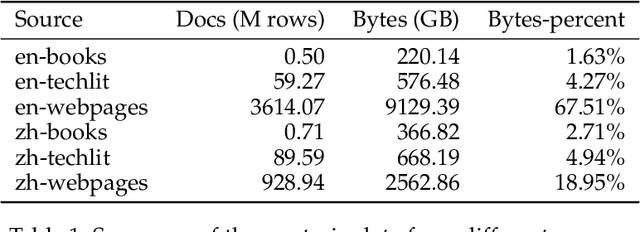
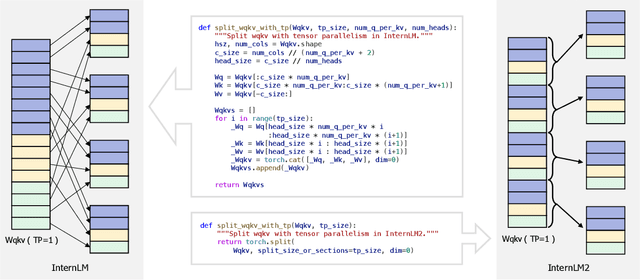

Abstract:The evolution of Large Language Models (LLMs) like ChatGPT and GPT-4 has sparked discussions on the advent of Artificial General Intelligence (AGI). However, replicating such advancements in open-source models has been challenging. This paper introduces InternLM2, an open-source LLM that outperforms its predecessors in comprehensive evaluations across 6 dimensions and 30 benchmarks, long-context modeling, and open-ended subjective evaluations through innovative pre-training and optimization techniques. The pre-training process of InternLM2 is meticulously detailed, highlighting the preparation of diverse data types including text, code, and long-context data. InternLM2 efficiently captures long-term dependencies, initially trained on 4k tokens before advancing to 32k tokens in pre-training and fine-tuning stages, exhibiting remarkable performance on the 200k ``Needle-in-a-Haystack" test. InternLM2 is further aligned using Supervised Fine-Tuning (SFT) and a novel Conditional Online Reinforcement Learning from Human Feedback (COOL RLHF) strategy that addresses conflicting human preferences and reward hacking. By releasing InternLM2 models in different training stages and model sizes, we provide the community with insights into the model's evolution.
AnyGPT: Unified Multimodal LLM with Discrete Sequence Modeling
Feb 26, 2024



Abstract:We introduce AnyGPT, an any-to-any multimodal language model that utilizes discrete representations for the unified processing of various modalities, including speech, text, images, and music. AnyGPT can be trained stably without any alterations to the current large language model (LLM) architecture or training paradigms. Instead, it relies exclusively on data-level preprocessing, facilitating the seamless integration of new modalities into LLMs, akin to the incorporation of new languages. We build a multimodal text-centric dataset for multimodal alignment pre-training. Utilizing generative models, we synthesize the first large-scale any-to-any multimodal instruction dataset. It consists of 108k samples of multi-turn conversations that intricately interweave various modalities, thus equipping the model to handle arbitrary combinations of multimodal inputs and outputs. Experimental results demonstrate that AnyGPT is capable of facilitating any-to-any multimodal conversation while achieving performance comparable to specialized models across all modalities, proving that discrete representations can effectively and conveniently unify multiple modalities within a language model. Demos are shown in https://junzhan2000.github.io/AnyGPT.github.io/
Balanced Data Sampling for Language Model Training with Clustering
Feb 22, 2024
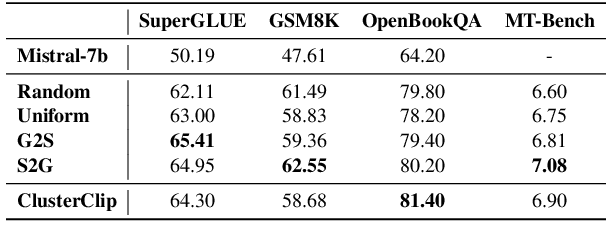
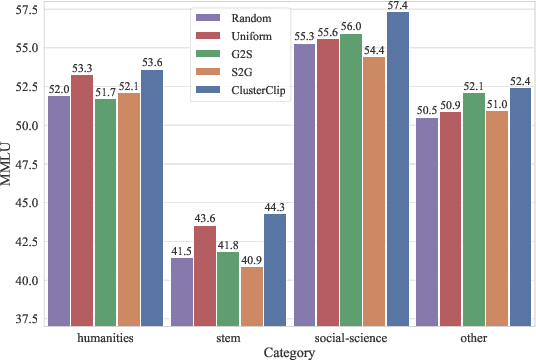
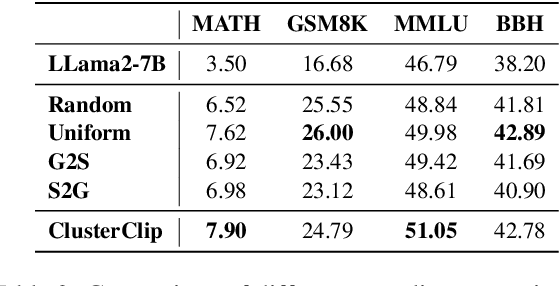
Abstract:Data plays a fundamental role in the training of Large Language Models (LLMs). While attention has been paid to the collection and composition of datasets, determining the data sampling strategy in training remains an open question. Most LLMs are trained with a simple strategy, random sampling. However, this sampling strategy ignores the unbalanced nature of training data distribution, which can be sub-optimal. In this paper, we propose ClusterClip Sampling to balance the text distribution of training data for better model training. Specifically, ClusterClip Sampling utilizes data clustering to reflect the data distribution of the training set and balances the common samples and rare samples during training based on the cluster results. A repetition clip operation is introduced to mitigate the overfitting issue led by samples from certain clusters. Extensive experiments validate the effectiveness of ClusterClip Sampling, which outperforms random sampling and other cluster-based sampling variants under various training datasets and large language models.
 Add to Chrome
Add to Chrome Add to Firefox
Add to Firefox Add to Edge
Add to Edge